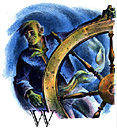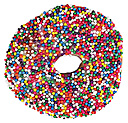We all know what a doughtnut looks like, right? It's a baked item in the shape of a circle with a hole in the middle, right? Well, that's the picture of one that is made in America. But some doughnuts don't have holes, others aren't really circular, and still others look entirely different. A doughnut isn't the same everywhere. It is, however, a food that has a fascinating history.
 Many historians credit the invention of the modern doughnut to a sailor, a Dutchman named Hanson Gregory. His mother, Elizabeth, was known to make a good olykoek, or "oily cake." She made some for him to take on one of his voyages, and she also sent along a recipe, so his cook could make some more. These cakes didn't have holes in them, however. One story says that the sea captain invented the donut by impaling one of the cakes on the ship's steering wheel, to keep his hands free in a sudden storm, on June 22, 1847. The spoke drove a hole through the wheel, naturally. Gregory discovered that he liked the cake better with a hole in the middle and ordered his cook to make them that way for the rest of the voyage.
Many historians credit the invention of the modern doughnut to a sailor, a Dutchman named Hanson Gregory. His mother, Elizabeth, was known to make a good olykoek, or "oily cake." She made some for him to take on one of his voyages, and she also sent along a recipe, so his cook could make some more. These cakes didn't have holes in them, however. One story says that the sea captain invented the donut by impaling one of the cakes on the ship's steering wheel, to keep his hands free in a sudden storm, on June 22, 1847. The spoke drove a hole through the wheel, naturally. Gregory discovered that he liked the cake better with a hole in the middle and ordered his cook to make them that way for the rest of the voyage.
 This is only one story, of course. Others have been put forward. It's not always a given that one single incident signalled the beginning of something. The doughnut could have been "invented" by many people in many different ways in different lands. The Hanson Gregory one is mentioned more than any other, so many historians go with that one as the most likely.
This is only one story, of course. Others have been put forward. It's not always a given that one single incident signalled the beginning of something. The doughnut could have been "invented" by many people in many different ways in different lands. The Hanson Gregory one is mentioned more than any other, so many historians go with that one as the most likely.
Another version of the same story is that Elizabeth Gregory made those olykoeks originally of two things—dough and nuts. That's how it got the name, at least in English. The dough was circular, and a nut was in the middle. The dough cooked around the nut; it wasn't like the nut was just stuck in a hole in the middle. So, the story goes, that Hanson Gregory, Elizabeth's son, requested that the nuts be taken out of them.
 Those who make doughnuts know, of course, that without anything in the middle, the doughnuts tend to cook faster and more evenly. So for the consumer, a doughnut with a hole is a good thing.
Those who make doughnuts know, of course, that without anything in the middle, the doughnuts tend to cook faster and more evenly. So for the consumer, a doughnut with a hole is a good thing.
Doughnut is the English term. Similar creations in other countries include the following:
- Aebelskiver, Danish doughnut look-alikes that have a slice of apple inside;
- Beignet, a French version of the doughnut;
- Berliners (or Bismarcks), German versions of doughnuts, usually filled with jelly;
- Oliebollen, a Dutch treat that contains a slice of apple and usually raisins and is traditionally served to celebrate the New Year;
- Zeppole, an Italian doughnut.
Doughnuts traditionally are circular and have a hole in the middle. However, other similar pastry items are called doughnuts as well. For instance, a doughnut that is thin and slender and has dough arranged in braids is called a cruller. Other kinds of pastries, like fritters, are also called doughnuts many times.
 Doughnuts gained in popularity in the U.S. after World War I. A New York businessman named Adolph Levitt invented the doughnut machine, and the little circular pastry became an even bigger hit. Today, doughnuts can be purchased just about anywhere. Some brands, like Krispy Kreme and Winchell's, are more well-known. But just about every bakery and food store makes and sells its own doughnuts, as do many people at home.
Doughnuts gained in popularity in the U.S. after World War I. A New York businessman named Adolph Levitt invented the doughnut machine, and the little circular pastry became an even bigger hit. Today, doughnuts can be purchased just about anywhere. Some brands, like Krispy Kreme and Winchell's, are more well-known. But just about every bakery and food store makes and sells its own doughnuts, as do many people at home.

No comments:
Post a Comment